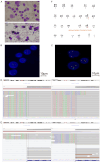Identification of novel NUP98::RARA fusion transcripts in acute promyelocytic leukemia with i(17)(q10) abnormality
- PMID: 40371152
- PMCID: PMC12070106
- DOI: 10.62347/UKFC7557
Identification of novel NUP98::RARA fusion transcripts in acute promyelocytic leukemia with i(17)(q10) abnormality
Abstract
Acute promyelocytic leukemia (APL) is one subtype of acute myeloid leukemia (AML) primarily associated with the typical fusion gene PML::RARA/t(15;17). A small percentage of APL cases are caused by atypical gene transcript variants lacking the PML::RARA. We report one case with two novel NUP98::RARA fusion transcripts in APL lacking the fusion gene PML::RARA/t(15;17). These NUP98::RARA fusion transcripts were identified using next-generation sequencing (NGS), which were confirmed by Sanger sequencing. One of the transcripts differs from the previously reported transcript in terms of break sites and transcript length, which identified as subtype of NUP98::RARA fusion transcript. The other one is the same as previously reported, demonstrating reproducible abnormality of this fusion gene. The patient was treated with all-trans retinoic acid (ATRA), realgar-Indigo naturalis formula (RIF) and chemotherapy. According to the published paper, this is the second report of NUP98::RARA fusion transcript in APL. It is also the first variant APL with der(11)(p15)t(11;17)(p15;q21) and i(17)(q10) chromosome abnormalities. Therefore, we compared and summarized these two cases.
Keywords: APL; NUP98::RARA; i(17)(q10); t(11;17)(p15;q21).
AJCR Copyright © 2025.
Conflict of interest statement
None.
Figures


Similar articles
-
A novel NUP98-JADE2 fusion in a patient with acute myeloid leukemia resembling acute promyelocytic leukemia.Blood Adv. 2022 Jan 25;6(2):410-415. doi: 10.1182/bloodadvances.2021006064. Blood Adv. 2022. PMID: 34673934 Free PMC article.
-
Interstitial insertion of retinoic acid receptor-alpha gene in acute promyelocytic leukemia with normal chromosomes 15 and 17.Blood. 1994 May 15;83(10):2946-51. Blood. 1994. PMID: 8180390
-
Acute Promyelocytic Leukemia with del(6)(p22) and Atypical bcr2 PML::RARA Fusion Transcript: A Case Report.Acta Haematol. 2023;146(1):58-64. doi: 10.1159/000527316. Epub 2022 Oct 5. Acta Haematol. 2023. PMID: 36198282
-
Utilization of RT-PCR and Optical Genome Mapping in Acute Promyelocytic Leukemia with Cryptic PML::RARA Rearrangement: A Case Discussion and Systemic Literature Review.Genes (Basel). 2024 Dec 25;16(1):7. doi: 10.3390/genes16010007. Genes (Basel). 2024. PMID: 39858554 Free PMC article.
-
Oral Realgar-Indigo Naturalis Formula Plus Retinoic Acid for Acute Promyelocytic Leukemia.Front Oncol. 2021 Feb 5;10:597601. doi: 10.3389/fonc.2020.597601. eCollection 2020. Front Oncol. 2021. PMID: 33614484 Free PMC article. Review.
References
-
- Wang ZY, Chen Z. Acute promyelocytic leukemia: from highly fatal to highly curable. Blood. 2008;111:2505–2515. - PubMed
-
- de Thé H, Chen Z. Acute promyelocytic leukaemia: novel insights into the mechanisms of cure. Nat Rev Cancer. 2010;10:775–783. - PubMed
-
- Adams J, Nassiri M. Acute promyelocytic leukemia: a review and discussion of variant translocations. Arch Pathol Lab Med. 2015;139:1308–1313. - PubMed
Publication types
LinkOut - more resources
Full Text Sources
